Pathways and Determinants of Early Spontaneous Vegetation Succession in Degraded Lowland of South China
Supported by the National Natural Science Foundation of China (No. 30200035) and Field Station Project of the Chinese Academy of Sciences (CAS) to Heshan Hilly Land Interdisciplinary Field Station, CAS
Abstract
Continuous and prolonged human disturbances have caused severe degradation of a large portion of lowland in South China, and how to restore such degraded ecosystems becomes an increasing concern. The process and mechanisms of spontaneous succession, which plays an important role in vegetation restoration, have not been adequately examined. To identify the pathways of early spontaneous vegetation succession, 41 plots representing plant communities abandoned over different times were established and investigated. The communities and indicator species of the vegetation were classified by analyzing the important values of plant species using multivariate analyses. The results indicated that the plant species could be classified into nine plant communities representing six succession stages. The pathway and species composition also changed in the process of succession. We also measured 13 environmental variables of microtopography, soil structure and soil nutrition in each plot to examine the driving forces of succession and the vegetation-environment relationships. Our results showed that the environmental variables changed in diverse directions, and that soil bulk density, soil water capacity and soil acidity were the most important factors.
Ecological restoration is intended to initiate or accelerate the recovery of an ecosystem in terms of its health, integrity and sustainability (SER 2004). Restoration is often closely related to the reconstruction of the structure, biological interactions, and related processes of the ecosystem (Hobbs and Norton 1996; Reay and Norton 1999; Ren and Peng 2001; Ren et al. 2004). The traditional approach to reclaiming degraded lowland in South China has been to plant fast-growing trees to minimize financial and human resource expenditures (Yu and Peng 1996). Plantations can achieve short-term socioeconomic goals by protecting the soil surface from erosion, by facilitating native species, and by accelerating the recovery of genetic diversity. However, spontaneous vegetation succession or natural recovery as an alternative approach to restoration has gained increasing attention (Bradshaw 1997; Pensa et al. 2004). Plant community succession is becoming one of the important aspects of restoration ecology and is the subject of a large body of ecological research (Zhang 2005).
Most studies on terrestrial vegetation succession have been focused on the restoration of abandoned mine land (Pensa et al. 2004; Martinez and Fernandez 2005; Dutta and Agrawal 2005), degraded grassland (Callaway and Davis 1993; Scholes and Archer 1997; Peintinger and Bergamini 2006; Bornkamm 2006), and forest land after deforestation or fire disturbance (Turner 1997; Calvo 2005; Hooper et al. 2005; Shimizu 2005; Choung and Hong 2006; Karlowski 2006). However, the pathways and determining factors of vegetation succession in degraded lowland are unclear, and little information is available.
Environmental degradation is especially serious in China. It is estimated that the total area under soil erosion is about 3.56 × 106 km2, accounting for 37.1% of national land (SEPA 2006). As a traditional approach, plantations may sometimes quickly increase forest coverage and rehabilitate degraded ecosystems. Most previous studies of ecological restoration focused on the selection of pioneer species and the development of engineering technology. However, few studies have examined the feasibility of restoration through spontaneous vegetation succession (Zhang 1994; Ren and Peng 2001; Peng 2003). With rapid economic development, many farmers are abandoning their agricultural fields and shifting to manufacturing. Consequently, many croplands are left untended. Moreover, large forestlands are degraded into grasslands because of intensive logging and poor management. In South China, Zhang (1994) found more than 3.74 × 106 ha of lowlands were degraded. In order to increase forest coverage and mitigate soil erosion, the national and local governments have devoted considerable amounts of human and financial resources to extend plantations. Fast growing species such as eucalypts (Eucalyptus citriodora, E. exserta, E. robusta) and pines (Pinus elliotii, Pinus massoniana) or nitrogen fixing species such as Acacia auriculaeformis have been widely used as pioneer species. However, negative effects, such as biodiversity loss, soil nutrient depletion (Madeira 1989), and soil acidification also occur but are largely overlooked. To avoid these problems, we must understand the processes and mechanisms of vegetation succession in degraded lowlands of South China.
The major objective of this study is to identify the pathways and mechanisms of vegetation succession associated with restoration processes in South China. Specifically, we address the following issues: (1) What are the early succession series of plant communities in South China? (2) Which environmental factors are the key “filters” to determine the vegetation composition and structure in succession; and (3) What are the most effective approaches to accelerate vegetation succession and to reach the “futuristic” restoration goal?
Results
Classification of succession stages
Based on TWINSPAN analysis, 60 species were classified into 9 groups, representing 6 succession stages (Figure 1).
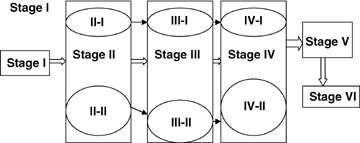
The restoration model of plant communities in degraded lowlands in South China.
-
Stage I (0–3 years after abandonment): This stage was the primary period of recovery. The plant coverage was low (10%) and the community composition was very simple. Plant species were few (less than 5) and mainly comprised decumbent and profuse root system species.
-
Stage II (3–5 years): This stage included two different community types (II-I: Imperata cylindrica and II-II: Lycopodium cernuum). Most of the plant species were gramineous species, which could tolerate the drought and infertile soils. Some leguminous species also appeared.
-
Stage III (5–12 years): This stage had two different community types (III-I: Glochidion eriocarpum plus Panax stipuleanatus, and III-II: Neyraudia neyraudiana plus Miscanthus sinensis). Most of the species were annual herbs. Many shrub species also appeared in the communities. The vegetation was generally dwarfed. This was the transition stage when many grass species were gradually replaced by shrub species.
-
Stage IV (12–17 years): This stage can be divided into two community types: IV-I: Eurya chinensis plus Rhaphiolepis indica. At the beginning of this stage, the dominant species was Dicranopteris linearis. Some shrub species such as Gardenia sootepensis and Rhaphiolepis indica were scattered in the community. However, at the end of this stage, the community structure changed dramatically and some shrub species, such as Sychotria rubra, Eurya chinensis, and Litsea rotundifolia oblongifolia colonized the community.IV-II: Litsea cubeba plus Litsea glutinosa. In contrast to IV-I, some gramineous species also appeared in this community. At the end of this stage, many broad-leaved species emerged.
-
Stage V (17–23 years): The dominance of shrubs over grasses became evident and many herbaceous species disappeared. Moreover, the coverage of vegetation greatly increased (about 80%).
-
Stage VI (23–30 years): The total vegetation cover reached 95%, and the herb species were highly restricted; their coverage was less than 20% as a result of the limited light. Both tree and shrub species were dominant. The community structure of this stage was relatively steady and could resist some extent of disturbance, resembling a “climax” community under natural conditions.
TWINSPAN analyses showed that, on the same substrate, there was a combination-separation-combination process of vegetation succession in degraded lowland, indicating two parallel paths in stages II, III, and IV, which finally combined in stage V (Figure 1).
Ordination analysis of succession
In the two-dimensional de-trended correspondence analysis (DCA) scatter diagram (Figure 2), axis 1 most likely represents the time course. From right to left, the succession periods become longer and the community composition and structure vary greatly. In stages I and II, there are few species and most of them rarely appear in the adjacent areas; the community boundary is clear. However, from stages III to IV, with the improvement of environment, species number increases. Accordingly, the community boundary becomes unclear. This is also embodied in the diagrams. Compared with stages I and II, the shapes of stages III, IV, and V are abnormal. Moreover, there are many transitional species which are distributed in the middle position of these three stages. In the end, an obvious change of plant diversity is observed in Figure 2. From stage I to stage VI, there was an increasing-decreasing process in the plant diversity.
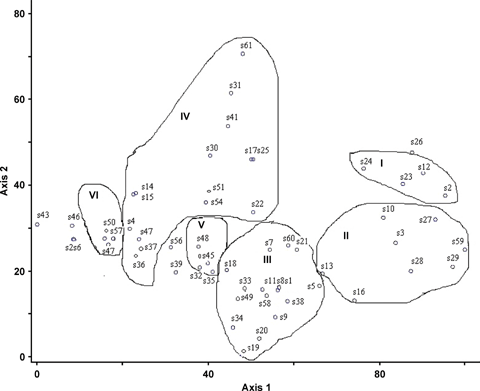
De-trended correspondence analysis ordination of the 60 species at six successional stages. The S + Arabic numbers and P + Arabic numbers represent species and quadrats, respectively.
Figure 2 shows plots of the same succession stages with similar ordination scores. When compared with Figure 3, we found the quadrats at the same stages had similar positions in both diagrams. This indicates that the environmental factors of the community change significantly from one stage to the next, and the species composition varies with the environmental changes.
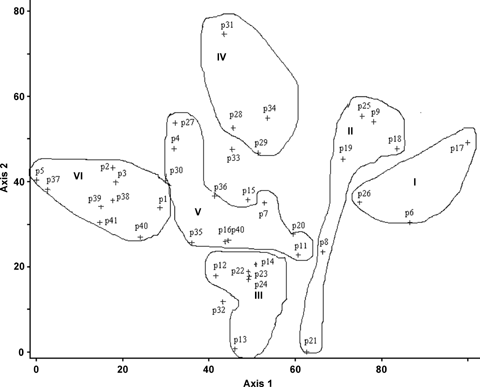
De-trended correspondence analysis ordination of the 41 quadrats in six succession stages based on species composition.
Changes of species number and composition
During succession, the number of species and the species composition changed over time (Figure 5). During the early succession stages of vegetation restoration, the fluctuation of species number was obvious. During all six succession stages, the species number in different life forms changed in different ways. Overall, the temporal pattern of herb and shrub species was parallel to that of total species number. However, the change of shrubs lagged behind that of herbs. In stages V and IV, the herbs decreased rapidly, but shrubs were still increasing. The species number of lianes changed randomly at all six succession stages, probably because the lianes could better adapt to the environment, and the species number was small. The tree species increased in the last three stages.

Changes of species number of different life forms during the six successional stages.
In general, pioneer species at the study site were heliophytes which could endure drought and lean times. During the first two stages, pioneer species dominated the community. However, as succession progressed, the microenvironment ameliorated and the proportion of pioneer species decreased. This trend was more obvious in the last two stages. In these two stages, trees and tall shrubs dominated the communities, while many heliophytes, especially herbs and shrubs, were shaded out and a few mesophytes and shade-tolerant species colonized the understorey. In the first two stages, most species had large numbers of small seeds mainly dispersed by wind. In the late stages, however, more species had larger seeds that were mainly dispersed by animals.
Changes of environmental factors
There was a steady reduction of soil bulk density (SBD) during the six succession stages, suggesting that the soil structure improved during the succession process. Moreover, this was more obvious in the first four stages because the vegetation cover increased dramatically in these stages and played an important role in water and soil conservation. The changing pattern of soil saturation moisture (SSM) and soil capillary moisture (SCM) was completely opposite to that of SBD. This indicates that changing SBD played an important role in the increase of soil moisture. The pH decreased slowly during the succession, possibly because the acidity of the laterite substrate was relatively high. At the beginning of succession, surface soil was eroded and the soil substrate became exposed because of low vegetation cover. The pH would decrease as a result of the effects of the ensuing pedogenic process. Soil organic matter greatly increased during succession, especially in the late stages, probably as a result of the increase of plant biomass and litter. In the first three stages, there was little hydrolyzed nitrogen accumulated in the soil, but this situation changed at the late stages. Available phosphorus and exchangeable potassium in the soil showed an increase at the beginning and a decrease later during the succession, which possibly resulted from complex interactions between the changes in pH and soil organic matter along the successional process (Figure 7).
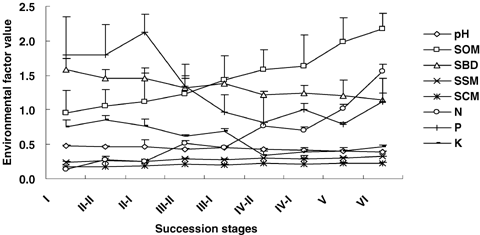
Changes of dominant environmental factors along the six successional stages. pH (× 10); SOM, soil organic matter (× 10 g/kg); SBD, soil bulk density (g/cm3); SSM, soil saturation moisture (× 100%); SCM, soil capillary moisture (× 100%); N, hydrolyzed nitrogen (× 103 mg/kg); P, available phosphorus (mg/kg); K, exchanged potassium (× 102 mg/kg).
Analysis of determining environmental factors
The length of lines in the canonical correspondence analysis (CCA) ordination diagram indicates the strength of the correlation between plant communities and the environment, and the angle between two lines represents their relativity. Figure 8 shows that SBD, soil moisture, nitrogen, and pH were the most important factors in vegetation restoration. The soil of our sites was acidic laterite, with a pH ranging from 3.6 to 5. Soil pH can affect vegetation succession in several ways. First, it could filter out certain species and thus change the community composition. Second, many essential elements such as phosphous, calcium and magnesium are affected. For example, Figures 8 shows that these elements were positively correlated with pH, suggesting that pH could also affect vegetation restoration by restricting the availability of some soil elements. Third, pH can affect the quantity and activity of soil microorganisms which play important roles in vegetation succession. The two CCA ordination diagrams also indicate that SBD and soil moisture are two important factors. At the beginning of the succession, the soil was poor with high SBD and low organic matter content. Accordingly, the soil water holding capacity was low, leading to greater soil erosion. The diagrams also show that SCM and SSM are negatively related to SBD, indicating that the improving soil structure was favorable for vegetation restoration. At the same time, slope and aspect of a catchment could affect the spatial–temporal distribution of water and heat. Generally, soil erosion was more serious in steep lowland. The accumulation of soil organic matter and minerals was relatively low in these areas, and this effect was more pronounced in monsoon areas. Nitrogen and soil organic matter were easily decomposed and relatively little was accumulated in the soil because of the high temperature and intense drying-rewetting process. However, at the later stages, the microenvironment was improved; the accumulation of soil organic matter and minerals increased. Therefore nitrogen and soil organic matter became more important in late succession.

Canonical correspondence analysis ordination diagram of the 60 species and 13 environmental factors from 41 quadrats.
Discussion
Factors controlling vegetation succession
Vegetation succession and ecological restoration represent processes in community assembly that involve a series of filters and thresholds sifting species out of the regional pool (Díaz et al. 1998; Whisenant 1999; Temperton et al. 2004). It has been recognized that the importance and action of different filters will vary from place to place and over time through restoration (Woodward and Diament 1991; Temperton et al. 2004). In extremely degraded sites, environmental stresses act as abiotic filters and only some pioneer species may be able to tolerate the severe conditions. South China is in the lower subtropical monsoon region. The annual precipitation is about 1 700 mm and the rainfall is generally intense, causing surface runoff which usually peels off the fertile topsoil, especially in hilly land. Consequently, the soil becomes extremely lean, acidic and compact, and thus functions as an abiotic filter. In these severely degraded areas, some pioneer gramineous species that have extensive root systems can tolerate strong acidity and drought. As pioneer species, these species can reduce surface runoff, accumulate soil organic matter, and improve soil structure, thus acting as nurse plants to facilitate the colonization of later species. They are also keystone species in transition of the threshold controlled by abiotic limitations. In the first four stages, abiotic filters determined the fate of vegetation restoration and the species composition was very simple, the vegetation cover was low, and thus the competition was weak. However, as succession progressed, the substrate improved, more species emerged, and plant cover increased; therefore, competition became stronger. For example, in late succession, many species were shaded out and the total species richness declined. In general, the importance of biotic filters increases along with succession.
There are also five different kinds of plantations in the study site, which are 23 years old. The understorey vegetation was compared with 23 years of natural restoration. Most heliophytes such as Rhodomyrtus tomentosa and Baeckea frutescens were scanty under all plantations. However, shade-tolerant species such as Psychotria rubra and Circaea mollis became the most important components of the understorey community. This indicated the importance of light in late succession. When the forest canopy closed, understorey vegetation would shift from heliophytes to mesophytes and shade-tolerant species. A common observation in both plantations and grassland was that few native tree saplings were established. Comparison of microclimate, soil minerals, and soil structure with those of native forest showed that these environmental factors may be less important, because native saplings can survive in native forests with harsh environments (Peng 2003). Seed sources and seed dispersal may be the most important biotic factors in late succession. Few seeds of native species were found during our vegetation and seed bank survey. In general, the species have large numbers of small seeds at the early stages and most of these seeds can be dispersed by wind for great distances, with little dispersal barrier. However, most of the native tree species such as Castanopsis chinensis, Cryptocarya chinensis, Aporosa yunnanensis, and C. fissa have larger seeds and only appear in late stages. If the distance between the native forests and degraded land is large, seed dispersal of heavy seeds is more difficult. Dispersal barrier may be the most important biotic filter in the late succession stages.
It is always difficult to comprehensively analyze many environmental factors in a single study. Here we identified and analyzed 13 environmental factors, and concluded that pH, SBD and soil moisture were the most important environmental factors in vegetation restoration in the study area. However, soil organic matter and nitrogen were considered to be the dominant environmental factors in many previous studies. This difference could be due to the mineralization of nitrogen, and the comparatively faster decomposition of organic matter at our study site. In addition, some essential minerals were swept away by surface runoff from the heavy rainfall in the region. Consequently, the nitrogen and organic matter content were similar in the first four stages and could not be the limiting factors. However, the soils of our study sites are acidic and the availability of phosphorus, potassium, calcium, and magnesium were closely correlated with pH. Therefore, soil acidity could be a determinant of vegetation succession. Although the laterite soil has strong capillary attraction and is difficult for rain water to infiltrate, the evaporation is high and precipitation varies greatly between seasons. Thus, soil moisture is also an important factor affecting vegetation succession. It should be pointed out, however, that these observations may only apply to early succession stages and the situation may be different in later succession stages.
The community assembly models
There are three models of community assembly, deterministic, stochastic, and alternative stable states (ASS). Most ecologists tend to agree that the ASS model of species assembly is likely to be the one that better reflects reality in nature (Temperton et al. 2004). This model asserts that communities are structured and restricted to a certain extent, but can be developed into numerous states because an element of randomness can be inherent in all ecosystems (Sutherland 1974; Gleick 1987). In our study, the vegetation succession did not follow one fixed pathway; instead, it was diverted into two parallel directions during early stages which then incorporated in the late stages. This conclusion is different from early studies of spontaneous succession (Scholes and Archer 1997; Calvo 2005; Bornkamm 2006; Karlowski 2006), but seems to support the ASS theory.
Many factors can result in the formation of different communities and succession pathways. Soil seed banks vary greatly across space partly due to their different distances from seed sources; therefore, seed dispersers can affect the colonization of certain species. Consequently, the sequences of species settlement can be quite different. For example, early settled species always affect the colonization of latter species. In addition, different environmental conditions gave rise to different communities in sites with identical species pools, as clearly illustrated at stage IV (4, 5, 6, 7). At this stage, plots with better soil structure and high nitrogen content were mainly occupied by Dicranopteris linearis. The coverage was relatively high. However, in plots with relatively poorer soil structure and nutrient condition, pioneer species such as Miscanthus sinensis were abundant.
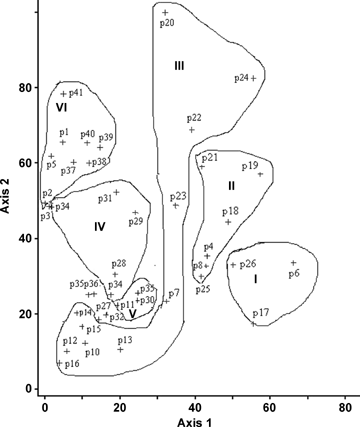
De-trended correspondence analysis ordination of the 41 quadrats in six successional stages based on their environmental conditions.

Changes of species composition during the six successional stages.
Conclusions
Our results clearly show that, in order to accelerate the restoration process, some immediate new strategies need to be planned and adopted. On the one hand, a more flexible restoration plan should be in place. The climax communities may be different because vegetation succession and ecological restoration are determined by somewhat different and uncertain factors. Moreover, because of the effect of microtopography, microclimate, and substrates, vegetation succession may be diverted into different trajectories, and various patterns can be observed at the same succession stage. Therefore, establishing self-sustaining ecosystems with abundant species and integrated function should be the goal of restoration. On the other hand, different steps should be taken to accelerate the transition past thresholds at different restoration stages. The first step is to reduce water loss and soil erosion, as soil erosion is one of the most serious problems in South China. We will then need to enhance soil pH and improve soil structure. In late stages of restoration, increasing the seed supply may be helpful to facilitate seed dispersal and sapling establishment (Guo 2007).
Materials and Methods
Study site
The study was conducted at Heshan Hilly Land Interdisciplinary Experimental Station (112° 54′ E, 22° 41′ N) located in Heshan County, Guangdong, China. The station was established in 1984 and it is located in a degraded coastal ecosystem in central Guangdong with a typical subtropical monsoon climate. Its elevation varies from 0 to 90 m. The soil is laterite, a type of heavy acid soil with little soil organic matter (about 18.03 g/kg), nitrogen (total N is about 0.86 g/kg) and available phosphorus (1.33 mg/kg). The mean annual temperature is 21.7 °C, the mean rainfall is 1 700 mm, and the mean evaporation is 1 600 mm. The region is a hilly agricultural zone with 78.6% of hilly land, 17.1% of farming land, and 4.3% of water body. The vegetation is typical subtropical evergreen broad-leaved forest. Representative species of climax communities are Cryptocarya concinna and C. chinensis. As a result of human disturbance, much of the current vegetation is degraded into hilly land grassland.
Field and laboratory methodology
To study the composition and structure of various plant communities, quadrat samples were set up at different succession stages. Quadrats of 20 m × 20 m, 5 m × 5 m, and 1 m × 1 m were used for investigating the vegetation of tree, shrub, and grass species, respectively. Three small quadrats for grassland or shrub land were nested in the large ones for shrub land and tree land. In each quadrat, the height, density, and basal diameter of various tree and shrub species, as well as the height and coverage of different grass species were recorded. In order to get accurate coverage of grasses, a 1 m × 1 m frame with small panes (5 cm × 5 cm) was used. The cover of grasses was determined by counting the number of panes covered by grasses. A total of 41 plots at different succession stages were established and investigated.
Soil samples were randomly collected from five points in each quadrat using a 5 cm-diameter soil corer to a depth of 20 cm, after removing surface litter. A composite soil sample of about 1 kg from each point was collected, air-dried and sieved for analysis of soil chemical characteristics (Institute of Soil Science, CAS 1978; Liu et al. 1996). To measure the soil physical characteristics, nine intact soil cores were taken randomly in each quadrat using ring knives, after removing the litter and humus layer, and three of them were used to determine the SBD, soil saturate moisture, and soil capillary moisture, respectively.
Data analysis


| Code | Name | Code | Name |
|---|---|---|---|
| S1 | Dicranopteris linearis | S31 | Smilax china |
| S2 | Cynodon dactylon | S32 | Embelia laeta |
| S3 | Imperata cylindrica | S33 | Microlepia hancei |
| S4 | Circaea mollis | S34 | Lygodium japonicum |
| S5 | Polygonum chinensis | S35 | Clerodendron fortunatum |
| S6 | Melastoma dodecandrum | S36 | Psychotria rubra |
| S7 | Miscanthus sinensis | S37 | Eurya chinensis |
| S8 | Blechnum orientale | S38 | Melastoma candidum |
| S9 | Rubus alceaefolius | S39 | Wikstroemia indica |
| S10 | Paederia scandens | S40 | Rhaphiolepis indica |
| S11 | Mussaenda pubescens | S41 | Ficus hirta |
| S12 | Ischaemum indicum | S42 | Glochidion eriocarpum |
| S13 | Lycopodium cernuum | S43 | Panax stipuleanatus |
| S14 | Schizoloma heterophyllum | S44 | Mallotus apelta |
| S15 | Adiantum capillus-veneris | S45 | Litsea cubeba |
| S16 | Adiantum flabellulatum | S46 | Litsea rotundifolia |
| S17 | Lophatherum gracile | S47 | Gardenia sootepensis |
| S18 | Dianella ensifolia | S48 | Rhodomyrtus tomentosa |
| S19 | Dianella ensifolia | S49 | Baeckea frutescens |
| S20 | Neyraudia neyraudiana | S50 | Evodia lepta |
| S21 | Fimbristylis dichotoma | S51 | Litsea glutinosa |
| S22 | Abrus precatorius | S52 | Trema cannabina |
| S23 | Desmodium triflorum | S53 | Schefflera octophylla |
| S24 | Eupatorium catarium | S54 | Ilex asprella |
| S25 | Panicum repens | S55 | Pinus massoniana |
| S26 | Urena lobata | S56 | Breynia fruticosa |
| S27 | Murdannia triquetra | S57 | Mimosa sepiaria |
| S28 | Desmodium heterocarpon | S58 | Setaria viridis |
| S29 | Hedyotis diffusa | S59 | Pseudosasa hindsii |
| S30 | Cassytha filiformis | S60 | Ficus variolosa |
Frequency refers to the percentage of the quadrat containing a tree species over the total quadrats at the same succession stage and stands. Dominance value refers to the sum of the basal areas of a tree or shrub species within a quadrat. We developed a matrix of IVs of 60 species × 41 plots and used it as the basis of the succession analysis. First, we used two-way indicator-species analysis (TWINSPAN; Hill 1979) to classify the succession stages of the communities. Second, we analyzed the relationships between the succession stages by de-trended correspondence analysis (DCA; Hill and Gauch 1980). Finally, the relationships between vegetation and environmental factors were analyzed using canonical correspondence analysis (CCA; Braak 1986).
(Handling editor: Jian-Xin Sun)
Acknowledgements
The authors are indebted to Dr Zhian Li, Jingping Zhang and Zuoyun Yin for helpful suggestions. The authors thank Bi Zou for soil analysis, Fuwu Xing for plant species identification, and Yongbiao Lin for field assistance.




